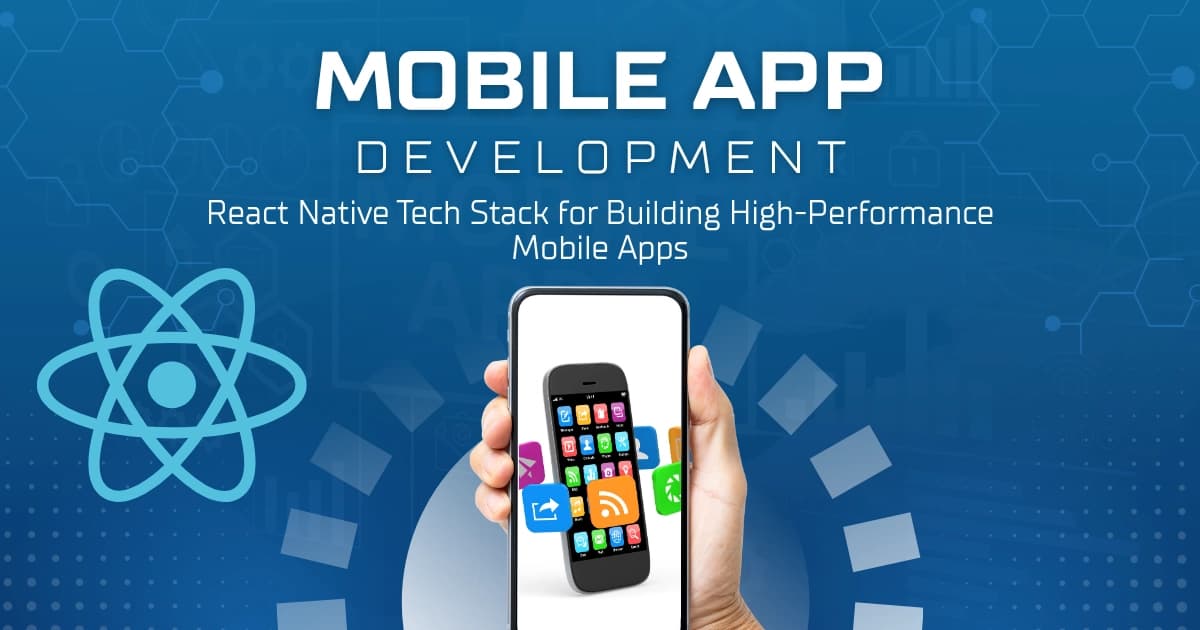React Native Tech Stack: Build High-Performance Mobile Apps Efficiently
Explore the React Native tech stack to build high-performance mobile apps efficiently. Learn about components, tools, strategies, and best practices for fast, maintainable, and seamless cross-platform app development.
![[object Object] profile picture](/_next/image?url=%2Fteam-placeholder.webp&w=128&q=75)
Manjeet Singh
- Oct 16, 2025

In today’s mobile landscape, users expect smooth animations, near-instant loading, and seamless interactions. At the same time, businesses want to ship quickly, reuse code, and maintain a single codebase. That’s where React Native shines—enabling cross-platform mobile development with the promise of native performance, efficient development, and broad reach.
In this article, we’ll dive deep into the React Native tech stack: components, tools, strategies, and real-world lessons, with a focus on how to deliver high-performance mobile apps while maximizing development efficiency. By the end, you’ll have a full picture of what makes a robust React Native architecture, how to pick the right tools, and how to optimize for speed, maintainability, and user delight.
Why Choose React Native for Cross-Platform Mobile Development
Write once, run anywhere (iOS & Android): With React Native, you build a large portion of your app logic once in JavaScript/TypeScript and share it across platforms. reactnative.dev+1
Native look & feel: React Native doesn’t just render web views—it uses native components (via a "bridge") so UI feels more authentic and performant.
Strong community & ecosystem: Mature libraries, tools, and community support make solving common problems easier.
Faster iteration & development efficiency: Hot reload, a rich development toolset, and code reuse accelerate development.
Cost efficiency: Maintaining one codebase reduces long-term development and maintenance cost compared to separate native apps.
However, cross-platform frameworks often carry a reputation of being less performant than native apps. The truth is, with the right architecture and optimizations, React Native can approach native-level performance in many scenarios.
Let’s now explore what “performance” really means in React Native, and how to assemble a tech stack that supports it.
Understanding Performance in React Native
Before picking tools, you need to understand where performance bottlenecks typically arise in React Native apps. Some key aspects:
Frame rate & smooth UI: A target of 60 FPS (or at least 30 FPS) is common. React Native aims to deliver native-level smoothness rather than fallback to WebView-based rendering. reactnative.dev+1
JS → Native bridging overhead: Communication between the JavaScript thread and native modules can incur overhead, especially for frequent interactions or large payloads.
Memory usage & garbage collection: Inefficient objects, large data payloads, and mismanagement of data can lead to jank or memory pressure.
Rendering & reconciliation costs: Too many component updates, unnecessary re-renders, or large trees can slow down UI updates.
Bundle size & startup time: A heavy JS bundle or many dependencies can delay app startup or initial load.
Native modules & heavy computations: If you rely heavily on native modules or heavy CPU tasks, mismanaging threads can degrade performance.
To build a high-performance mobile app with React Native, your tech stack must be designed to mitigate these bottlenecks. Let’s dissect what a robust stack looks like.
Core Components of a React Native Tech Stack
Below is a breakdown of the essential layers and libraries that constitute a mature React Native architecture.
Runtime / JavaScript Engine
Hermes: A lightweight JavaScript engine optimized for mobile, introduced by Facebook/Meta. It reduces startup time, memory usage, and latency of interactions. Many React Native projects now adopt Hermes by default.
JSC (JavaScriptCore): The default engine (especially on iOS) in older setups. While mature, it's less optimized for mobile than Hermes in many cases.
Threading / JSI / TurboModules / Fabric: Modern React Native uses JSI (JavaScript Interface) and new architecture (Fabric, TurboModules) to reduce bridging overhead and make modules more direct and efficient.
By choosing Hermes and modern architectures (JSI + Fabric), you lay a foundation for performance.
Architecture & Native Bridge / Threading
The bridge connects JavaScript and native code. Minimizing frequent small calls across the bridge is key.
Use batching, flattening, and memoization to reduce JS–Native chatter.
Move heavy computations off the JS thread into native modules or worker threads (e.g., via react-native-threads or WebWorkers-like patterns).
Embrace the new architecture (TurboModules and Fabric) to reduce overhead in native module access.
State Management & Data Layer
Choosing an efficient state management strategy is critical:
Redux / Redux Toolkit: The classic, battle-tested choice. Use selectors, memoization (reselect), and slice-based design to avoid over-rendering.
MobX / MobX-state-tree: Observable-based system that can reduce boilerplate and unnecessary updates.
Recoil / Jotai / Zustand: More lightweight, modern alternatives that allow fine-grained state updates.
React Context + useReducer: Adequate for smaller apps; avoid overusing context for global state.
Local caching & data layers: Tools like React Query or SWR (or Relay for GraphQL) help manage server state, caching, background refreshes, and cache invalidation.
Design your data flow to minimize re-renders, decouple global and local state, and isolate heavy updates.
Navigation & Routing
React Navigation: A highly popular, flexible navigation library supporting stacks, tabs, modals, deep linking, etc.
React Native Navigation (Wix): Alternative that offers more “native-like” navigation by using native view controllers.
React Router Native / React Router: Useful especially if you're targeting web + mobile.
Use lazy screens, code splitting, and dynamic navigation imports to reduce initial bundle load.
UI / Component Libraries
Instead of building every UI element from scratch, you can adopt robust UI component libraries that are optimized:
React Native Paper: Material Design–based components. ** React Native Elements:** A flexible UI toolkit with theming and easy customizations. BrowserStack+1
NativeBase / Gluestack: A utility-first component library (NativeBase evolves into Gluestack) for consistent cross-platform styling.
UI Kitten, Tamagui, Dripsy: Other performant, theme-driven UI frameworks.
Use memoization (React.memo, useMemo, useCallback) for heavy components. Avoid over-nesting deeply.
Networking, APIs & Data Fetching
Axios / fetch / got: For REST APIs.
GraphQL clients: Apollo Client, Relay, or urql for GraphQL backends.
React Query / TanStack Query: Helps caching, request deduplication, background updates, pagination.
WebSockets / realtime: Libraries like Socket.IO or WS for bidirectional updates.
Local caching / offline support: Use AsyncStorage, MMKV, WatermelonDB, or Realm for local persistence.
Batching / request bundling: Avoid many small calls; instead, batch multiple requests if possible.
Build System, Bundler, & Tooling
Metro bundler: The default bundler for React Native. It supports incremental bundling, hot reloading, and asset handling.
RAM bundles / inline requires: Techniques to break the JS bundle into chunks to reduce startup time.
CodePush / OTA updates: Tools like Microsoft’s CodePush (via App Center) allow pushing JS updates without re-submission to app stores.
Babel, ESLint, Prettier: Toolchain for transpiling and linting.
Flipper / DevTools: For debugging, logs, layout inspection. reactnative.dev+2codeparrot.ai+2
Use module aliasing, tree-shaking, and dead-code elimination to shrink bundle size.
Testing, Monitoring, & QA Tools
Unit / Integration testing: Jest (built-in with React Native), React Testing Library.
End-to-end (E2E) testing: Detox, Appium, or tools like Cypress (for web/hybrid).
Performance monitoring / crash analytics: Tools like Sentry, Bugsnag, Firebase Crashlytics.
Profiling & metrics: Use React Native’s built-in performance monitors, Flipper plugins, and custom instrumentation.
Logging & observability: Use centralized logging systems, structured logs (e.g. winston, pino) possibly with remote ingestion.
CI/CD & Deployment
CI services: Bitrise, GitHub Actions, CircleCI, Azure DevOps. Bitrise is popular for mobile pipelines.
CD / App Store deployment: Fastlane, App Center, TestFlight / Google Play Console automation.
Automated builds / parallelization: Use caching, artifacts, dependencies install caching, build caching.
Quality gates: Running tests, lint, code coverage, static analysis before merge.
Best Tools for React Native in 2025
As of 2025, several tools and libraries have emerged as the best choices for React Native app development, empowering developers to build high-performance mobile apps efficiently. Each serves a specific purpose in the development lifecycle—from rapid prototyping to performance monitoring—ensuring your React Native tech stack remains modern, stable, and scalable.
For rapid development and prototyping, Expo continues to be one of the most powerful frameworks. It provides a managed workflow with built-in APIs for essential mobile features such as the camera, location services, and push notifications. Expo also supports over-the-air (OTA) updates, which make it possible to push new JavaScript code directly to users without requiring a full app store redeployment. According to resources from Galaxies.dev, Debut Infotech, and Instabug, Expo significantly enhances development speed—especially during early iterations—while maintaining compatibility with the wider React Native ecosystem.
When developers require native-level control, the React Native CLI is the preferred choice. Unlike managed workflows, it provides full access to native modules, build configurations, and platform-specific customizations. This flexibility makes it ideal for projects demanding deep native integrations or advanced performance optimizations.
For debugging and development tools, Flipper and the new React Native DevTools (introduced in React Native 0.76+) have become indispensable. Flipper offers an extensive plugin ecosystem that includes layout inspection, network monitoring, and performance profiling. React Native DevTools integrates seamlessly with the ecosystem, replacing older debugging setups and improving visibility into app performance. As highlighted by React Native’s official documentation and Debut Infotech, these tools collectively streamline issue detection and debugging across both JavaScript and native layers.
For state management and data fetching, modern libraries like Redux Toolkit, React Query, and Zustand or Jotai are widely adopted. They simplify global state handling, enable cache synchronization, and minimize unnecessary re-renders—improving app responsiveness.
When it comes to UI components, frameworks such as React Native Elements, NativeBase (now Gluestack), React Native Paper, and Tamagui dominate the landscape. These toolkits are designed to accelerate interface development by offering ready-to-use, theme-driven components that adapt to both iOS and Android.
For testing and quality assurance, Jest and Detox remain the top tools of choice. Jest provides fast, snapshot-based unit testing, while Detox enables end-to-end (E2E) testing across real devices and emulators, ensuring your app behaves consistently under real-world conditions. Together, they create a solid testing foundation to prevent regressions and verify performance improvements.
Automation is another key aspect of a modern React Native tech stack. Tools such as Bitrise, Fastlane, and GitHub Actions help automate continuous integration and deployment (CI/CD) pipelines. They manage builds, run test suites, and publish to app stores automatically, reducing manual overhead and human error. As noted by Instabug, this automation ensures smoother releases and more reliable app updates.
Finally, no stack is complete without performance monitoring and optimization tools. Platforms like Sentry and Firebase Crashlytics provide real-time crash analytics, error tracking, and performance insights, while custom instrumentation allows developers to gather metrics tailored to their use case. These tools are essential for identifying regressions, crashes, and slow interactions before they impact users.
In real-world projects, teams often combine multiple tools for maximum efficiency—for example, using Expo during initial development for rapid iteration, then migrating to a custom React Native CLI setup for full control and scalability. A production-ready React Native stack might include Hermes for optimized runtime performance, React Navigation for intuitive user flows, Redux Toolkit and React Query for data handling, a curated UI library like Gluestack, and a robust CI/CD pipeline powered by Bitrise or Fastlane. When complemented with observability platforms such as Sentry, this combination delivers a powerful balance of speed, maintainability, and reliability for high-performance mobile apps.
Performance Optimization Strategies & Patterns
Here’s where experience and nuance matter. Below are strategies you should adopt (backed by real-world practice) to deliver high-performance mobile apps.
Lazy Loading & Code Splitting
Load only what’s needed. Use React.lazy, dynamic import(), or route-level splitting to reduce the initial JS bundle and speed app startup.
Inline Requires & RAM Bundles
React Native allows “inline requires” to defer module loading until use, and RAM bundles split JS code into modules. These reduce app startup time.
Memoization & Pure Components
Wrap heavy subcomponents in React.memo, use useMemo / useCallback, and avoid inline anonymous functions in render.
Throttling & Debouncing
For user interactions (scroll, input, animations), throttle or debounce event handlers to reduce excessive re-renders.
Minimize Expensive Reconciliations
Don’t update entire state objects; use shallow updates. Avoid deep nested props or arrays. Use selectors and derive data smartly.
Offload Work from JS Thread
If a task is heavy (image processing, data transformation), offload it to native modules or worker threads.
Use Native Animations / Reanimated
Avoid JS-driven animations when possible. Use react-native-reanimated or react-native-gesture-handler for smoother, native-driven animations.
Optimized Images & Assets
Use appropriately sized images, WebP format, compression, caching, and lazy load images offscreen.
Use Hermes & New Architecture
Hermes significantly improves start-up, memory, and GC behavior in many scenarios. The new architecture (Fabric, TurboModules) further reduces bridge overhead.
Profiling & Continuous Monitoring
Profile using DevTools, Flipper, React Profiler to identify bottlenecks. Watch for memory leaks, dropped frames, and slow operations. Use A/B testing or monitoring to detect performance regressions over versions.
These optimizations require careful balance—not every optimization is worth its complexity—but applying them selectively can dramatically improve user experience.
Trade-offs, Limitations & When Native Might Be Better
A truly transparent, trustworthy article must admit downsides. Here are limitations and trade-offs you’ll face in React Native:
Bridge overhead & complexity
For extremely performance-sensitive apps (e.g. 3D games, real-time media, AR/VR), the JS–native communication may become a bottleneck.
Native modules & compatibility
If your app leans heavily on custom native functionality or platform-specific APIs, integration and maintenance become complex.
UI consistency & platform quirks
Some UI behaviors on iOS vs Android need careful handling (e.g. keyboard, safe areas, platform styling).
Major version upgrades & breaking changes
Upgrading React Native versions (especially when adopting the new architecture) can be nontrivial in large apps.
Debugging complexity
Debugging cross-bridge, native + JS interactions can get tricky compared to pure native stacks.
Library maturity
Some third-party libraries might not support new architecture or may lag in maintenance. Always check compatibility.
In certain scenarios, native development (Swift/Objective-C for iOS, Kotlin/Java for Android) remains the superior choice—especially for apps needing extremely low-latency performance, GPU-intensive rendering, or deep hardware integration.
But for most business, productivity, e-commerce, content, or social apps, the trade-offs are acceptable when the stack is designed with care.
Best Practices for Efficiency & Maintainability
To build scalable, maintainable, and efficient React Native apps, follow these practices:
Modular structure / feature-based architecture
Organize code by feature/domain, not by component type. Encourage encapsulation and separation of concerns.
Clear interface boundaries
Keep components, UI, state, and networking loosely coupled. Use interfaces or typing (TypeScript) to enforce contracts.
Automated testing from day one
Even small units, snapshots, integration tests, and E2E flows. Guard against regressions.
Continuous integration & lint / code quality checks
Enforce linting, formatting, type checks, and tests in CI before merge.
Instrumentation & monitoring
Log performance metrics, track crash rates, and monitor CPU/memory usage in production.
Gradual upgrades & version pinning
Don’t jump many versions at once—upgrade incrementally and pin critical dependencies.
Documentation & onboarding
Maintain good README, code docs, architectural diagrams, and onboarding guides—especially for new team members.
Performance regression suite
Add performance benchmarks or synthetic flows in your CI so that new changes don’t degrade performance over time.
User feedback & error reporting
Collect real user feedback, monitor crashes, and iterate based on data, not assumptions.
Conclusion
React Native offers a powerful middle path between native performance and cross-platform development efficiency. With a well-thought-out tech stack, rigorous optimization, and real-world experience backing your choices, you can deliver high-performance mobile apps that delight users without reinventing the wheel.
From the user’s perspective, what matters most is smooth interactions, fast load times, and zero crashes. If your stack enables that—and your team can iterate fast—then you’ve hit the sweet spot.
Whether you’re a startup building your first mobile app, or a mature product aiming to improve performance, the principles in this post will help you shape a React Native architecture that is both efficient and sustainable.
Latest Posts

Integrating AI into Web Development: Frameworks and Future Trends
Manjeet Singh
Nov 12, 2025

NestJS: The Backbone of Modern Enterprise Applications
Manjeet Singh
Nov 6, 2025

Shopify App Development: Extending Your Store’s Functionality
Manjeet Singh
Oct 30, 2025

How to Build a Secure, Serverless Website Using Jamstack Architecture
Manjeet Singh
Oct 24, 2025

Why Developer Expertise Matters More Than Ever in the AI Era
Abhishek Bhardwaj
Oct 18, 2025